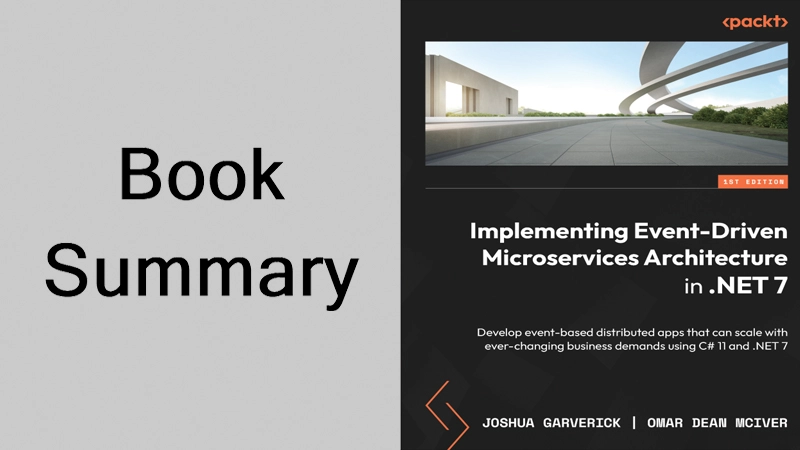
Book Summary: Implementing Event-Driven Microservices Architecture in .NET 7 by Josh Garverick and Omar Dean McIver - March 2023
Developing an event-driven distributed software system presents a plethora of complexities due to the inherent nature of handling asynchronous communication, distributed components, and event-driven interactions. Coordinating events, ensuring message reliability, and addressing fault tolerance are just a few of the intricate challenges that developers must address. Additionally, maintaining consistency and observability in such systems can be formidable as they scale. However, the book Implementing Event-Driven Microservices Architecture in .NET 7 brilliantly addresses these complexities, offering in-depth insights and practical solutions for building robust event-driven distributed systems. Moreover, the book keeps readers up-to-date with the latest technologies, including C# 11 and .NET 7, making it an invaluable resource for developers seeking to implement cutting-edge event-driven distributed solutions. In the following, you can read the chapter names along with a summary of each chapter.
- Chapter 1, "The Sample Application," provides an in-depth exploration of the sample application, starting with its architectural overview and delving into the implementation details of entities, value objects, services, factories, and aggregates.
- Chapter 2, "The Producer-Consumer Pattern," covers the foundational aspects of the producer-consumer pattern (also known as the publisher-subscriber pattern) and demonstrates its application in the book's example through code illustrations.
- Chapter 3, "Message Brokers," focuses on the intricacies and methods of implementing message brokers within the application's broader ecosystem. It defines the term "message broker," discusses technology examples, and guides readers in selecting the most suitable technology for their application needs.
- Chapter 4, "Domain Model and Asynchronous Design," provides detailed insights into the domain model, encompassing commands and events. It also covers the practical implementation of asynchronous events and their appropriate usage in the application.
- Chapter 5, "Containerization and Local Environment Setup," explores the utilization of containerization for isolating functionality during build and deployment processes. Readers will also learn how to configure their local environment to facilitate this workflow.
- Chapter 6, "Localized Testing and Debugging of Microservices," takes readers further into the local environment setup by introducing the Dockerfile. It guides readers in testing and debugging microservices in their local environment.
- Chapter 7, "Microservice Observability," examines different observability types at the service level, the frameworks, and technologies enabling observability. The chapter highlights the significance of enhanced observability for both developers and operations in the application's ecosystem.
- Chapter 8, "CI/CD Pipelines and Integrated Testing," provides an overview of common continuous integration (CI) and continuous delivery (CD) strategies. It demonstrates practical implementations using GitHub Actions and explains how to integrate baseline and regression testing into pipelines.
- Chapter 9, "Fault Injection and Chaos Testing," delves into the concepts of fault tolerance and fault injection in software testing. It explores more advanced testing methods like stress and chaos testing to validate resilience and fault tolerance.
- Chapter 10, "Modern Design Patterns for Scalability," reviews various design patterns aimed at achieving service scalability. It also covers implementing scalability constructs in popular deployment targets such as Kubernetes and Azure API applications.
- Chapter 11, "Minimizing Data Loss," imparts specific techniques to minimize or eliminate data loss during scaling operations and increased service resiliency. Paradigms like eventual consistency and guaranteed delivery are reviewed to help identify acceptable data loss.
- Chapter 12, "Service and Application Resiliency," assists readers in implementing patterns to guarantee service uptime, business continuity, and end-user satisfaction. It emphasizes generating meaningful messages for end users, handled through various methods.
- Chapter 13, "Telemetry Capture and Integration," explores different options for capturing application-level and service-level telemetry. It focuses on capturing relevant information while avoiding unnecessary noise or overhead, and how to aggregate meaningful telemetry.
- Chapter 14, "Observability Revisited," provides methodologies for publishing service metadata, cataloging and versioning microservice metadata, and promoting the discovery of shared services within an organization.


Leave a Reply
Your e-mail address will not be published. Required fields are marked *